Influence of Steel and Polypropylene Fibers on the Structural Behavior of Sustainable Reinforced Lightweight Concrete Beams Made from Crushed Clay Bricks
Abstract
:1. Introduction
2. Experimental Program
2.1. Materials
2.2. Details of Reinforced Concrete Beams
2.3. Experimental Setup
3. Results and Discussion
3.1. Concrete Slump
3.2. Concrete Density
3.3. Concrete Compressive Strength
3.4. Crack Patterns and Mode of Failure of Reinforced Beams
3.5. Effect of Fiber Volume on the Load–Deflection Response of Reinforced Beams
3.6. Steel Reinforcement Strains
4. Numerical Analysis
5. Conclusions
- LWC beams exhibited a considerable amount of deflection, which provided enough warning before failure. Moreover, the ductility of LWC beams was higher than that of normal-weight concrete beams.
- When PPF was added to LWC by up to 0.2% by volume, the ultimate load and displacement ductility significantly improved compared to fiberless LWC beams by about 16% and 24.7%, respectively.
- With the addition of 0.5% and 1.0% SF, the compressive strength of the LWC beams increased by approximately 11.8% and 17.6%, respectively, after 28 days. Similarly, 0.1% PPF and 0.2% PPF increased the compressive strength after 28 days by approximately 5.9% and 11.8%, respectively.
- Compared to the control beam, the ultimate load of all fiber-reinforced beams increased by an average of 16%. SF outperformed PPF in terms of effectiveness at reducing flexural cracks and enhancing crack control.
- The ductility of the beam was greatly improved by 20% when 0.1% PPF was added compared to the control beam, whereas 18% was lost when 0.5% SF was added.
- The numerical model’s results showed strong agreement with the experimental results, indicating that it might replace laboratory experiments in future studies.
Author Contributions
Funding
Data Availability Statement
Conflicts of Interest
References
- Narayanan, N.; Ramamurthy, K. Structure and properties of aerated concrete: A review. Cem. Concr. Compos. 2000, 22, 321–329. [Google Scholar] [CrossRef]
- Eltayeb, E.; Ma, X.; Zhuge, Y.; Xiao, J.; Youssf, O. Composite walls Composed of profiled steel skin and foam rubberized concrete subjected to eccentric compressions. J. Build. Eng. 2021, 46, 103715. [Google Scholar] [CrossRef]
- Eltayeb, E.; Ma, X.; Zhuge, Y.; Youssf, O.; Mills, J.E.; Xiao, J.; Singh, A. Structural performance of composite panels made of profiled steel skins and foam rubberised concrete under axial compressive loads. Eng. Struct. 2020, 211, 110448. [Google Scholar] [CrossRef]
- Sari, D.; Pasamehmetoglu, A.G. The effects of gradation and admixture on the pumice lightweight aggregate concrete. Cem. Concr. Res. 2005, 35, 936–942. [Google Scholar]
- Youssf, O.; ElGawady, M. An overview of sustainable concrete made with scrap rubber. In Proceedings of the 22nd Australasian Conference on the Mechanics of Structures and Materials ACMSM 22, Sydney, NSW, Australia, 11–14 December 2012; pp. 1039–1044. [Google Scholar] [CrossRef]
- Satish, C.; Berntsson, L. Lightweight Aggregate Concrete; Elsevier: Amsterdam, The Netherlands, 2002. [Google Scholar]
- Mostafa, S.A.; Faried, A.S.; Farghali, A.A.; El-Deeb, M.M.; Tawfik, T.A.; Majer, S.; Abd Elrahman, M. Influence of nanoparticles from waste materials on mechanical properties, durability and microstructure of UHPC. Materials 2020, 13, 4530. [Google Scholar]
- Younis, M.; Amin, M.; Tahwia, A.M. Durability and mechanical characteristics of sustainable self-curing concrete utilizing crushed ceramic and brick wastes. Case Stud. Constr. Mater. 2022, 17, e01251. [Google Scholar] [CrossRef]
- Yi, O.; Zhuge, Y.; Ma, X.; Gravina, R.J.; Mills, J.E.; Youssf, O. Push-off and Pull-out Bond Behaviour of CRC Composite Slabs—An Experimental Investigation. Eng. Struct. 2020, 228, 111480. [Google Scholar] [CrossRef]
- Tam, V.W.Y.; Soomro, M.; Evangelista, A.C.J. A review of recycled aggregate in concrete applications (2000–2017). Constr. Build. Mater. 2018, 172, 272–292. [Google Scholar] [CrossRef]
- Hansen, T. Recycling of Demolished Concrete and Masonry; CRC Press: Boca Raton, FL, USA, 2004. [Google Scholar]
- Kumutha, R.; Vijai, K. Strength of concrete incorporating aggregates recycled from demolition waste. ARPN J. Eng. Appl. Sci. 2010, 5, 64–71. [Google Scholar]
- Debieb, F.; Kenai, S. The use of coarse and fine crushed bricks as aggregate in concrete. Constr. Build. Mater. 2008, 22, 886–893. [Google Scholar] [CrossRef]
- Liu, Q.; Li, B.; Xiao, J.; Singh, A. Utilization potential of aerated concrete block powder and clay brick powder from C&D waste. Constr. Build. Mater. 2019, 238, 117721. [Google Scholar] [CrossRef]
- Cachim, P.B. Mechanical properties of brick aggregate concrete. Constr. Build. Mater. 2009, 23, 1292–1297. [Google Scholar] [CrossRef]
- Zheng, C.; Lou, C.; Du, G.; Li, X.; Liu, Z.; Li, L. Mechanical properties of recycled concrete with demolished waste concrete aggregate and clay brick aggregate. Results Phys. 2018, 9, 1317–1322. [Google Scholar] [CrossRef]
- Zhao, Y.; Gao, J.; Chen, F.; Liu, C.; Chen, X. Utilization of waste clay bricks as coarse and fine aggregates for the preparation of lightweight aggregate concrete. J. Clean. Prod. 2018, 201, 706–715. [Google Scholar] [CrossRef]
- Adem, H.; Athab, E.; Thamer, S.; Jasim, A. The behavior of Lightweight Aggregate Concrete Made with Different Types of Crushed Bricks. IOP Conf. Ser. Mater. Sci. Eng. 2019, 584, 012040. [Google Scholar] [CrossRef]
- Ali, Y.M.S. Effect of Silica Fume on the Behavior of Lightweight RC Beams Made from Crushed Bricks; Springer: Berlin/Heidelberg, Germany, 2022. [Google Scholar]
- Aliabdo, A.A.; Abd-Elmoaty, A.-E.M.; Hassan, H.H. Utilization of crushed clay brick in concrete industry. Alex. Eng. J. 2014, 53, 151–168. [Google Scholar] [CrossRef]
- Helmy, S.H.; Tahwia, A.M.; Mahdy, M.G.; Elrahman, M.A.; Abed, M.A.; Youssf, O. The Use of Recycled Tire Rubber, Crushed Glass, and Crushed Clay Brick in Lightweight Concrete Production: A Review. Sustainability 2023, 15, 10060. [Google Scholar] [CrossRef]
- Duan, Z.; Hou, S.; Xiao, J.; Singh, A. Rheological properties of mortar containing recycled powders from construction and demolition wastes. Constr. Build. Mater. 2019, 237, 117622. [Google Scholar] [CrossRef]
- Mobili, A.; Giosuè, C.; Corinaldesi, V.; Tittarelli, F. Bricks and Concrete Wastes as Coarse and Fine Aggregates in Sustainable Mortars. Adv. Mater. Sci. Eng. 2018, 2018, 8676708. [Google Scholar] [CrossRef]
- Wongsa, A.; Sata, V.; Nuaklong, P.; Chindaprasirt, P. Use of crushed clay brick and pumice aggregates in lightweight geopolymer concrete. Constr. Build. Mater. 2018, 188, 1025–1034. [Google Scholar] [CrossRef]
- Yang, J.; Du, Q.; Bao, Y. Concrete with recycled concrete aggregate and crushed clay bricks. Constr. Build. Mater. 2011, 25, 1935–1945. [Google Scholar] [CrossRef]
- Madandoust, R.; Kazemi, M.; Yousefi Moghadam, S. Analytical study on tensile strength of concrete. Rev. Romana De Mater. 2017, 47, 204. [Google Scholar]
- Toufigh, V.; Abyaneh, M.J.; Jafari, K. Study of Behavior of Concrete under Axial and Triaxial Compression. ACI Mater. J. 2017, 114, 619. [Google Scholar] [CrossRef]
- Hassanli, R.; Youssf, O.; Vincent, T.; Mills, J.E.; Manalo, A.; Gravina, R. Experimental study on compressive behavior of FRP-confined expansive rubberized concrete. J. Compos. Constr. 2020, 24, 04020034. [Google Scholar]
- Li, J.; Niu, J.; Wan, C.; Liu, X.; Jin, Z. Comparison of flexural property between high performance polypropylene fiber reinforced lightweight aggregate concrete and steel fiber reinforced lightweight aggregate concrete. Constr. Build. Mater. 2017, 157, 729–736. [Google Scholar] [CrossRef]
- Sadrmomtazi, A.; Tahmouresi, B.; Saradar, A. Effects of silica fume on mechanical strength and microstructure of basalt fiber reinforced cementitious composites (BFRCC). Constr. Build. Mater. 2018, 162, 321–333. [Google Scholar] [CrossRef]
- Saradar, A.; Tahmouresi, B.; Mohseni, E.; Shadmani, A. Restrained Shrinkage Cracking of Fiber-Reinforced High-Strength Concrete. Fibers 2018, 6, 12. [Google Scholar] [CrossRef]
- Yousefi Moghadam, S.; Ranjbar, M.M.; Madandoust, R.; Kazemi, M. Analytical study on the behavior of corrosion-damaged reinforced concrete beams strengthen with FRP. Rev. Romana De Mater. 2017, 47, 514–521. [Google Scholar]
- Aulia, T.B. Effects of Polypropylene Fibers on the Properties of High-Strength Concretes; Institutes for Massivbau and Baustoffechnologi, University Leipzig: Saxony, Germany, 2002; Volume 7. [Google Scholar]
- Banthia, N.; Gupta, R. Influence of polypropylene fiber geometry on plastic shrinkage cracking in concrete. Cem. Concr. Res. 2006, 36, 1263–1267. [Google Scholar] [CrossRef]
- Fallah, S.; Nematzadeh, M. Mechanical properties and durability of high-strength concrete containing macro-polymeric and polypropylene fibers with nano-silica and silica fume. Constr. Build. Mater. 2017, 132, 170–187. [Google Scholar] [CrossRef]
- Yan, H.; Sun, W.; Chen, H. The effect of silica fume and steel fiber on the dynamic mechanical performance of high-strength concrete. Cem. Concr. Res. 1999, 29, 423–426. [Google Scholar] [CrossRef]
- Balendran, R.; Zhou, F.; Nadeem, A.; Leung, A. Influence of steel fibres on strength and ductility of normal and lightweight high strength concrete. J. Affect. Disord. 2002, 37, 1361–1367. [Google Scholar] [CrossRef]
- Habel, K.; Gauvreau, P. Response of ultra-high performance fiber reinforced concrete (UHPFRC) to impact and static loading. Cem. Concr. Compos. 2008, 30, 938–946. [Google Scholar] [CrossRef]
- Shafigh, P.; Mahmud, H.; Jumaat, M.Z. Effect of steel fiber on the mechanical properties of oil palm shell lightweight concrete. Mater. Des. 2011, 32, 3926–3932. [Google Scholar] [CrossRef]
- Hassanpour, M.; Shafigh, P.; Bin Mahmud, H. Mechanical Properties of Structural Lightweight Aggregate Concrete Containing Low Volume Steel Fiber. Arab. J. Sci. Eng. 2014, 39, 3579–3590. [Google Scholar] [CrossRef]
- Ramadevi, K.; Venkatesh, B.D.L. Flexural Behavior of Hybrid (Steel-Polypropylene) Fiber Reinforced Concrete Beams. Eur. J. Sci. Res. 2012, 70, 81–87. [Google Scholar]
- Prasad, M.; Rajeev, C.; Rakesh, G. A comparative study of polypropylene fibre reinforced silica fume concrete with plain cement concrete. Int. J. Eng. Res. Sci. Technol. 2013, 2, 127–136. [Google Scholar]
- Thirumurugan, S.; Sivakumar, A. Compressive strength index of crimped polypropylene fibres in high strength cementitious matrix. World Appl. Sci. J. 2013, 24, 698–702. [Google Scholar]
- Jusoh, W.A.; Ibrahim, I.S.; Sam, A.R. Flexural behaviour of reinforced concrete beams with discrete steel–polypropylene fibres. In MATEC Web of Conferences; EDP Sciences: Les Ulis, France, 2017; Volume 101. [Google Scholar]
- Peng, Z.; Qingfu, L. Fracture Properties of Polypropylene Fiber Reinforced Concrete Containing Fly Ash and Silica Fume. Res. J. Appl. Sci. Eng. Technol. 2013, 5, 665–670. [Google Scholar]
- Sanjuán, M.A.; Argiz, C. The new European standard on common cements specifications EN 197-1: 2011. Mater. De Construcción 2012, 62, 425–430. [Google Scholar] [CrossRef]
- Standard, A. Standard Test Method for Slump of Hydraulic-Cement Concrete; ASTM Annual Book of ASTM Standards; ASTM Standards: West Conshohocken, PA, USA, 2015. [Google Scholar]
- Mohod, M.V. Performance of steel fiber reinforced concrete. Int. J. Eng. Sci. 2012, 1, 1–4. [Google Scholar]
- Zohrabi, M.; Zohrabi, A.; Chermahini, A.G. Investigation of the mechanical properties of lightweight concrete containing LECA with Metakaoline Pozzolan using polypropylene and steel fibers. J. Appl. Environ. Biol. Sci. 2015, 5, 11–15. [Google Scholar]
- Mohamed, A.M.; Tayeh, B.A.; Abu Aisheh, Y.I.; Salih, M.N.A. Exploring the performance of steel fiber reinforced lightweight concrete: A case study review. Case Stud. Constr. Mater. 2023, 18, e01968. [Google Scholar] [CrossRef]
- Balaguru, P.; Ramakrishnan, V.J.M.J. Properties of fiber reinforced concrete: Workability, behavior under long-term loading, and air-void characteristics. Mater. J. 1988, 85, 189–196. [Google Scholar]
- Albu-Hassan, N.H.; Al-Thairy, H. Experimental and numerical investigation on the behavior of hybrid concrete beams reinforced with GFRP bars after exposure to elevated temperature. Structures 2020, 28, 537–551. [Google Scholar] [CrossRef]
- Smith, M. ABAQUS/Standard User’s Manual, Version 6.9; Dassault Systèmes Simulia Corp: Providence, RI, USA, 2009. [Google Scholar]
- ACI 318-14; Building Code Requirements for Structural Concrete. ACI (American Concrete Institute): Farmington Hills, MI, USA, 2014.

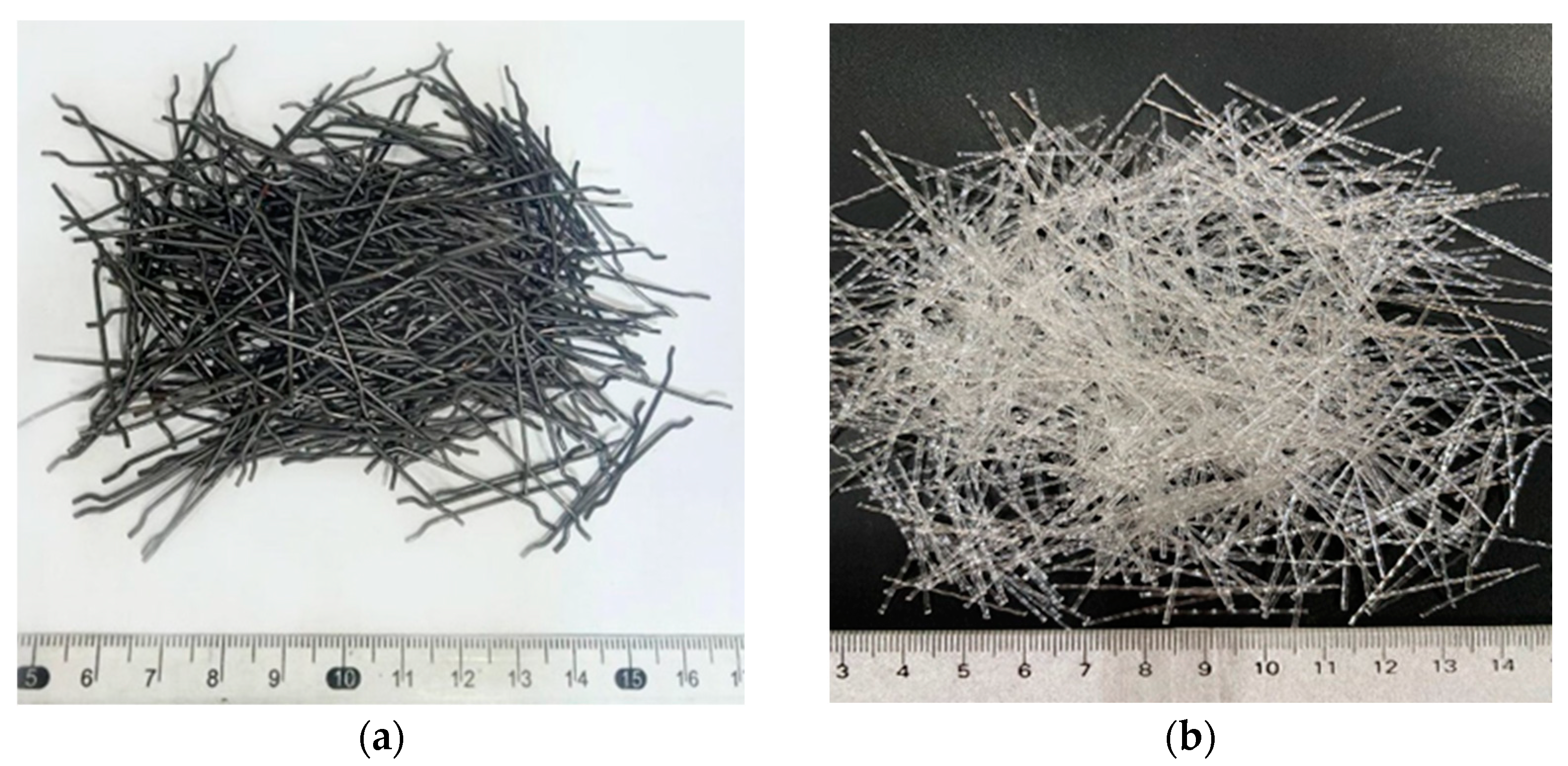

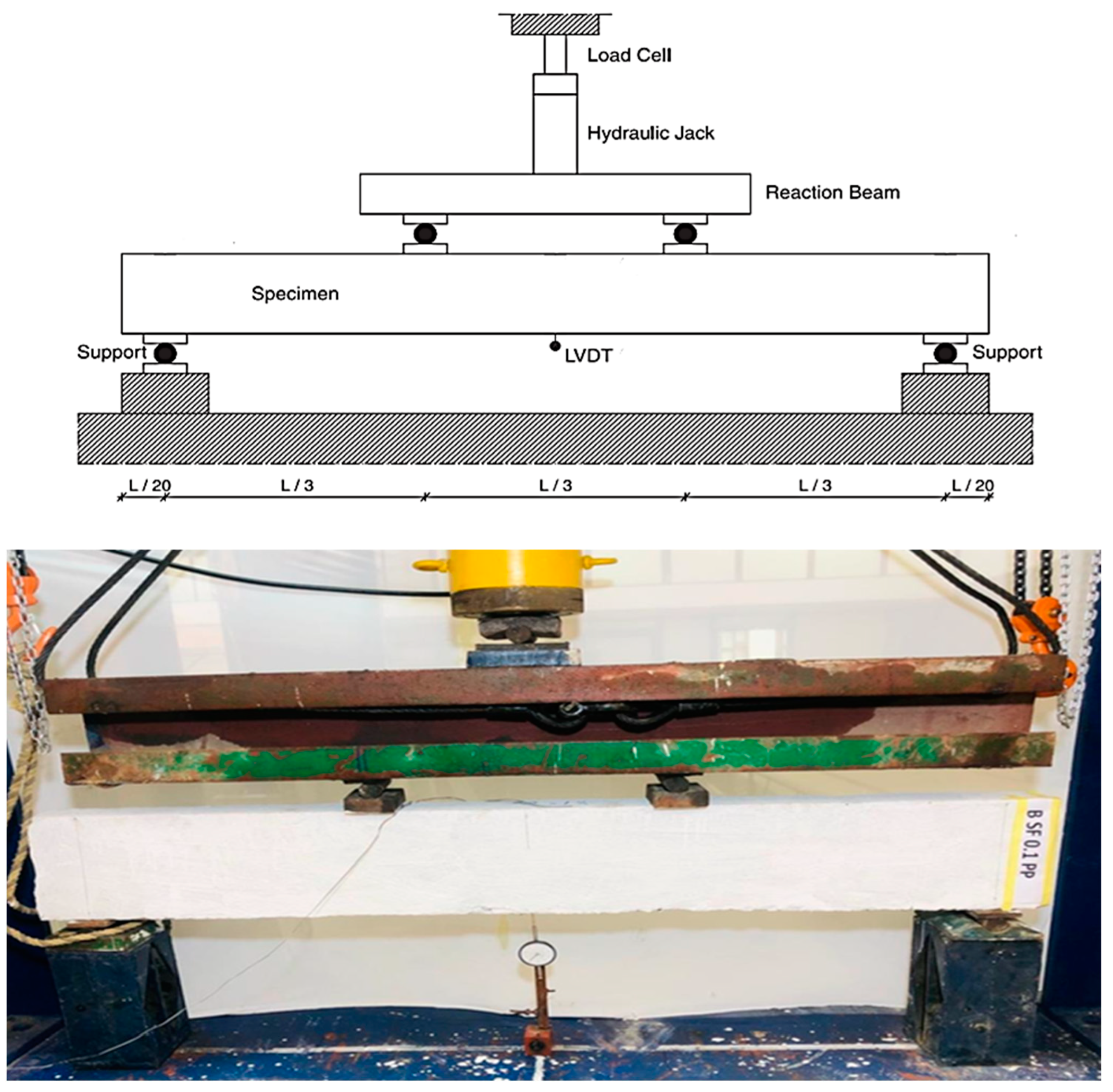
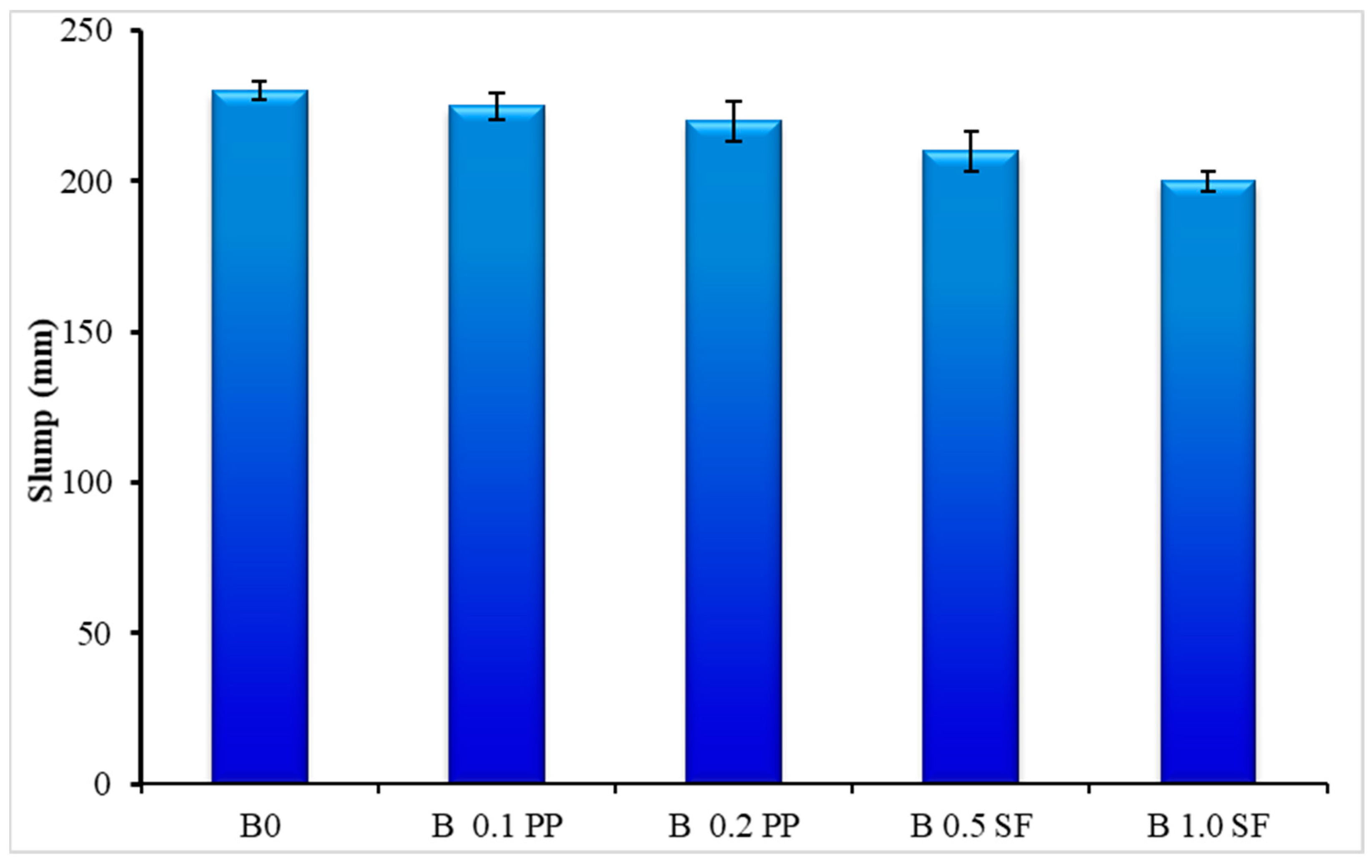
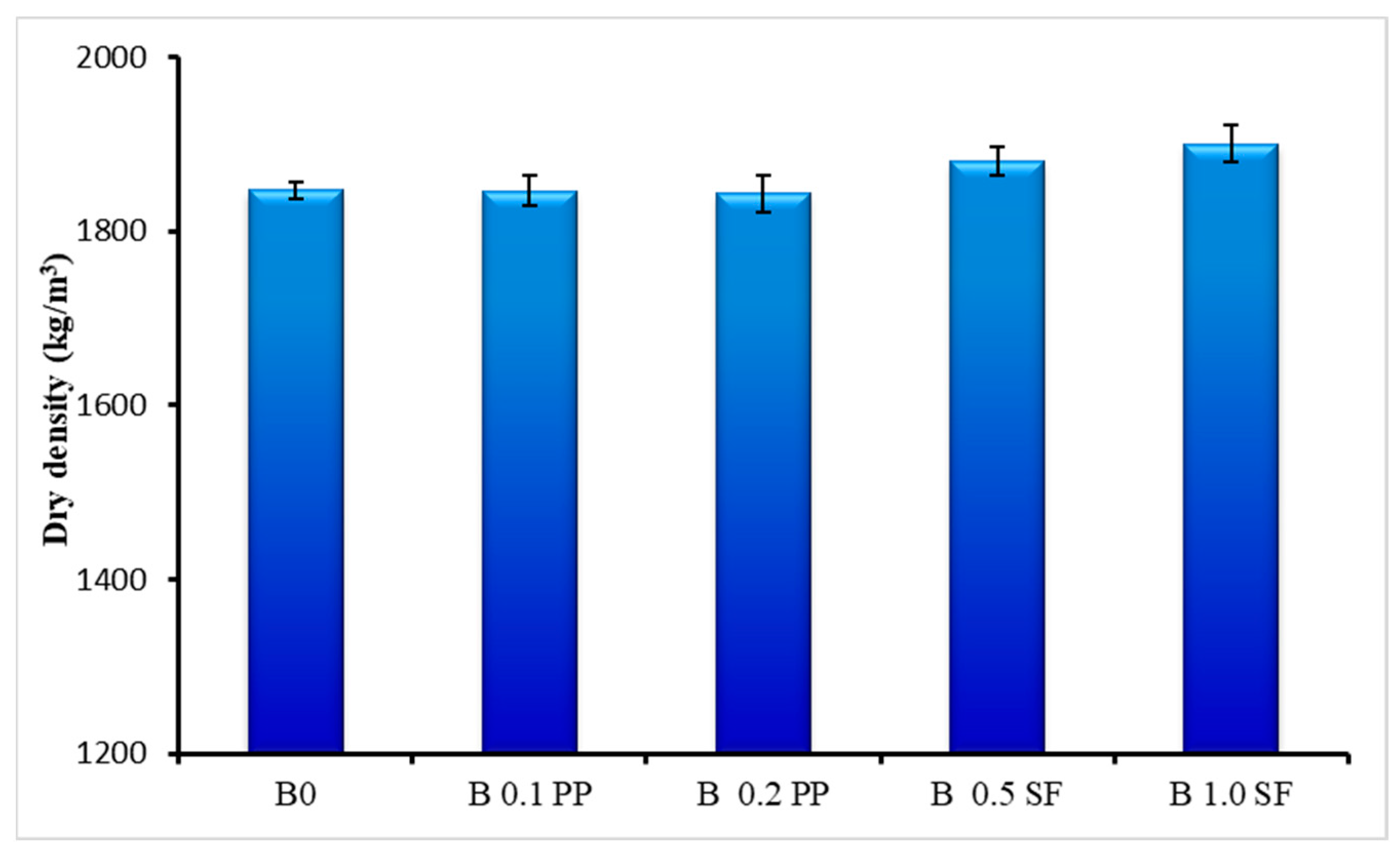
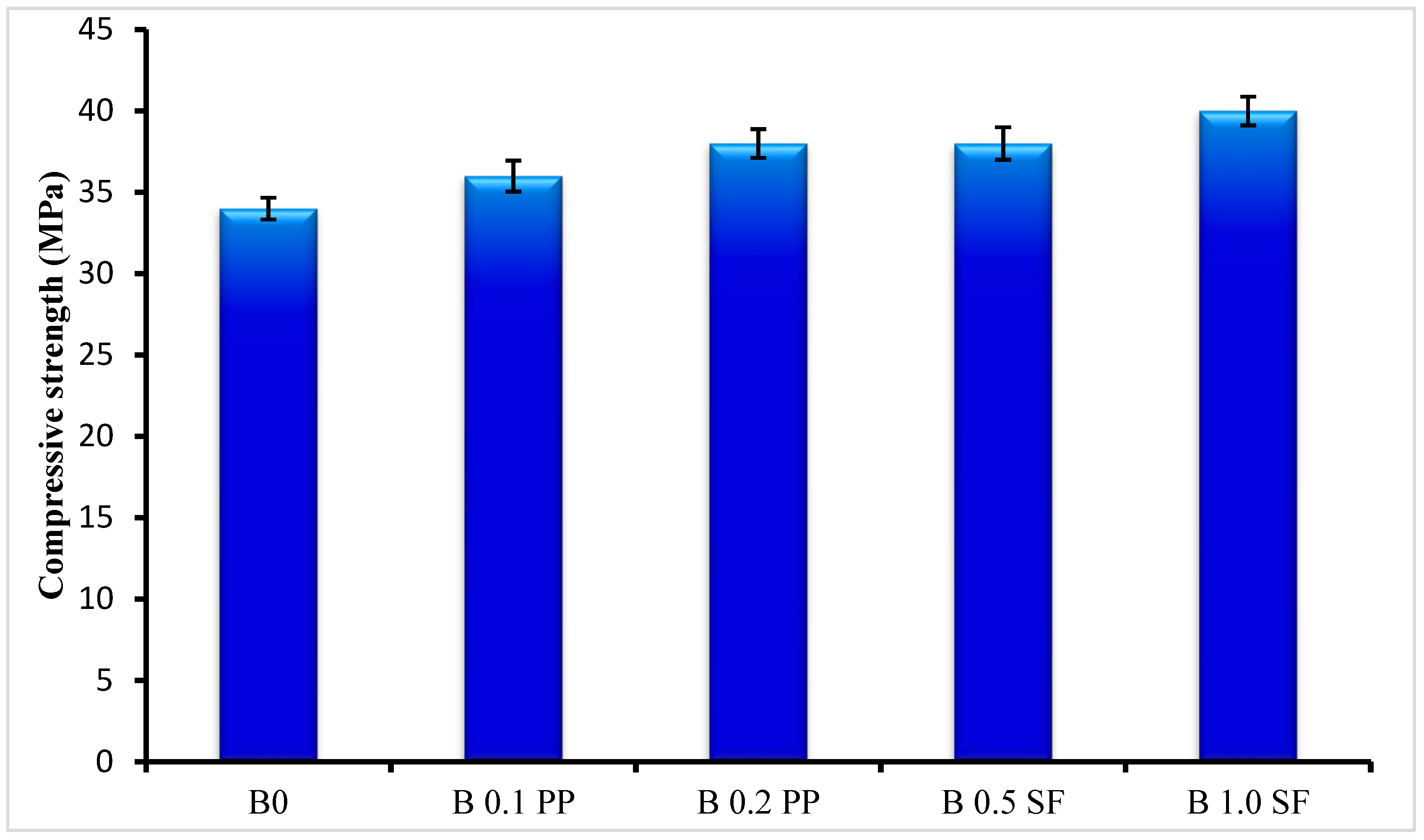
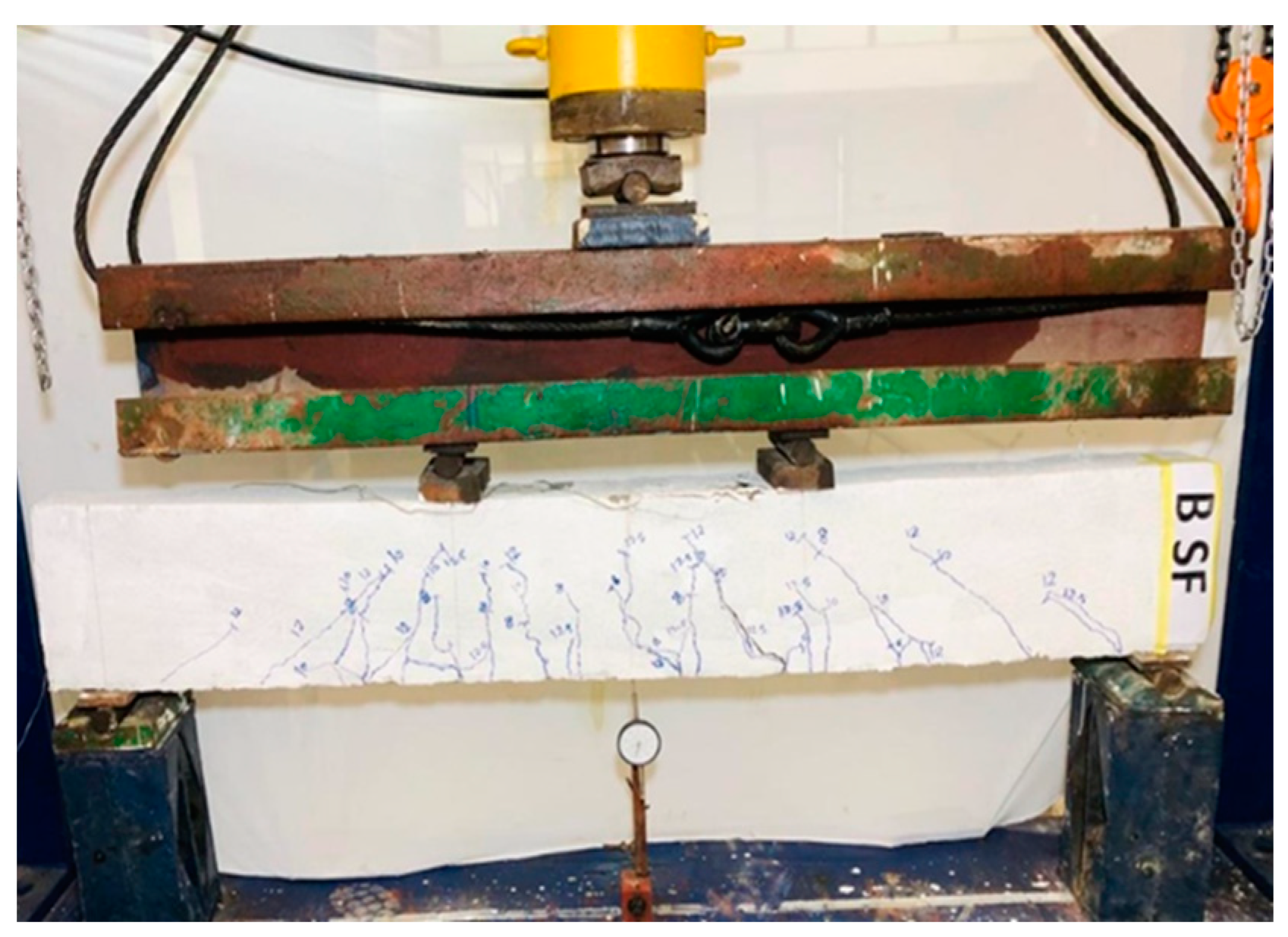
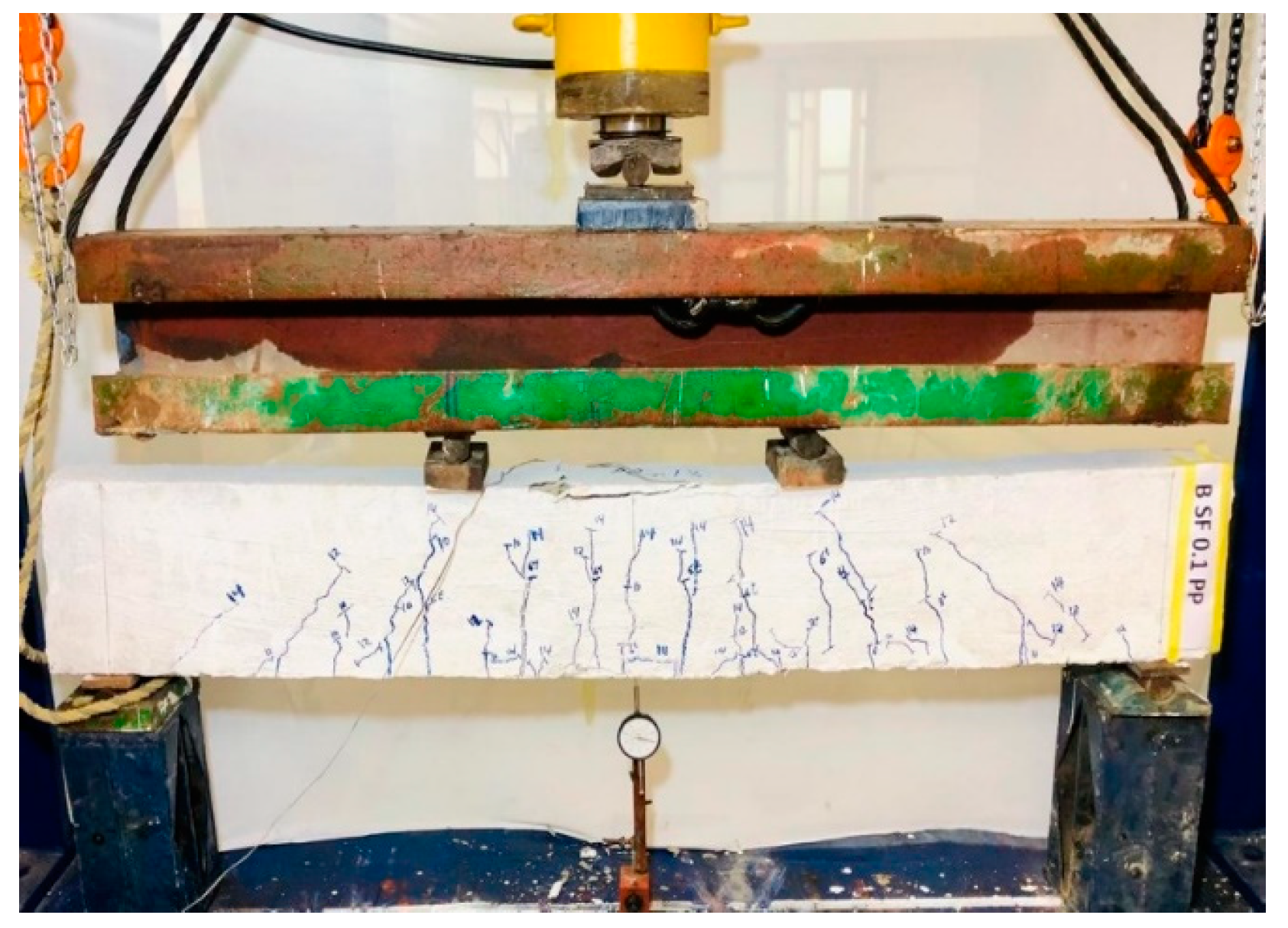
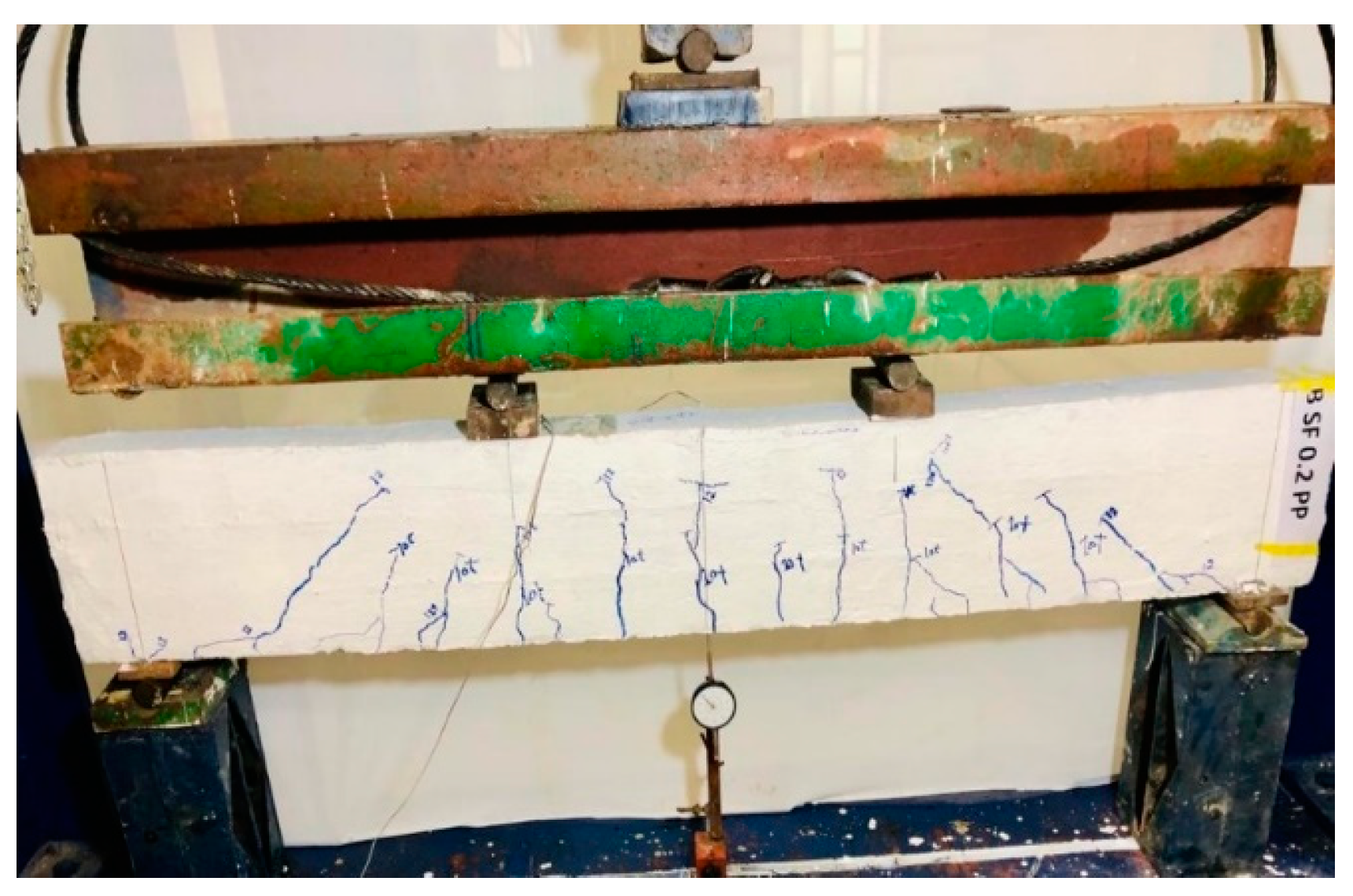

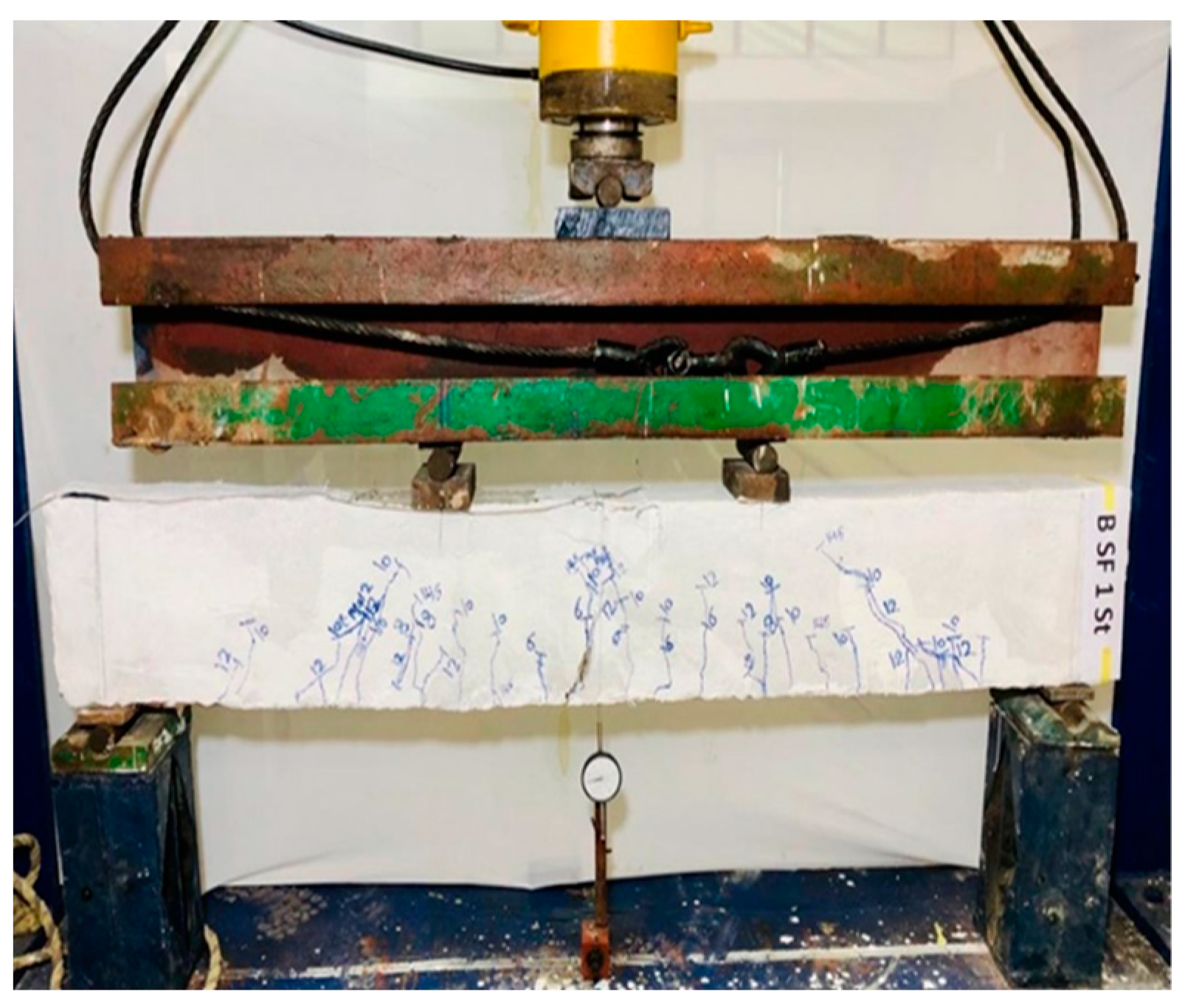



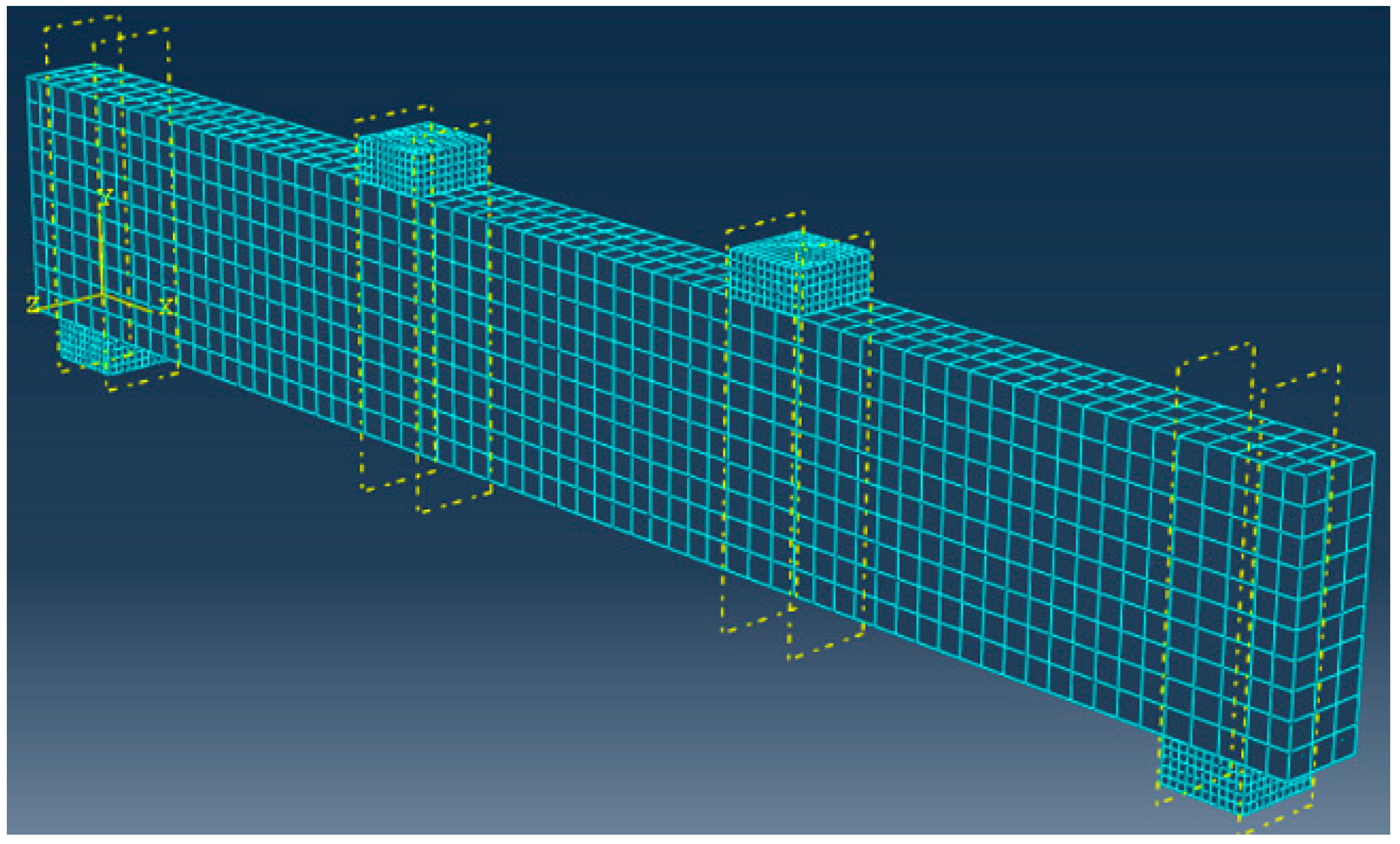

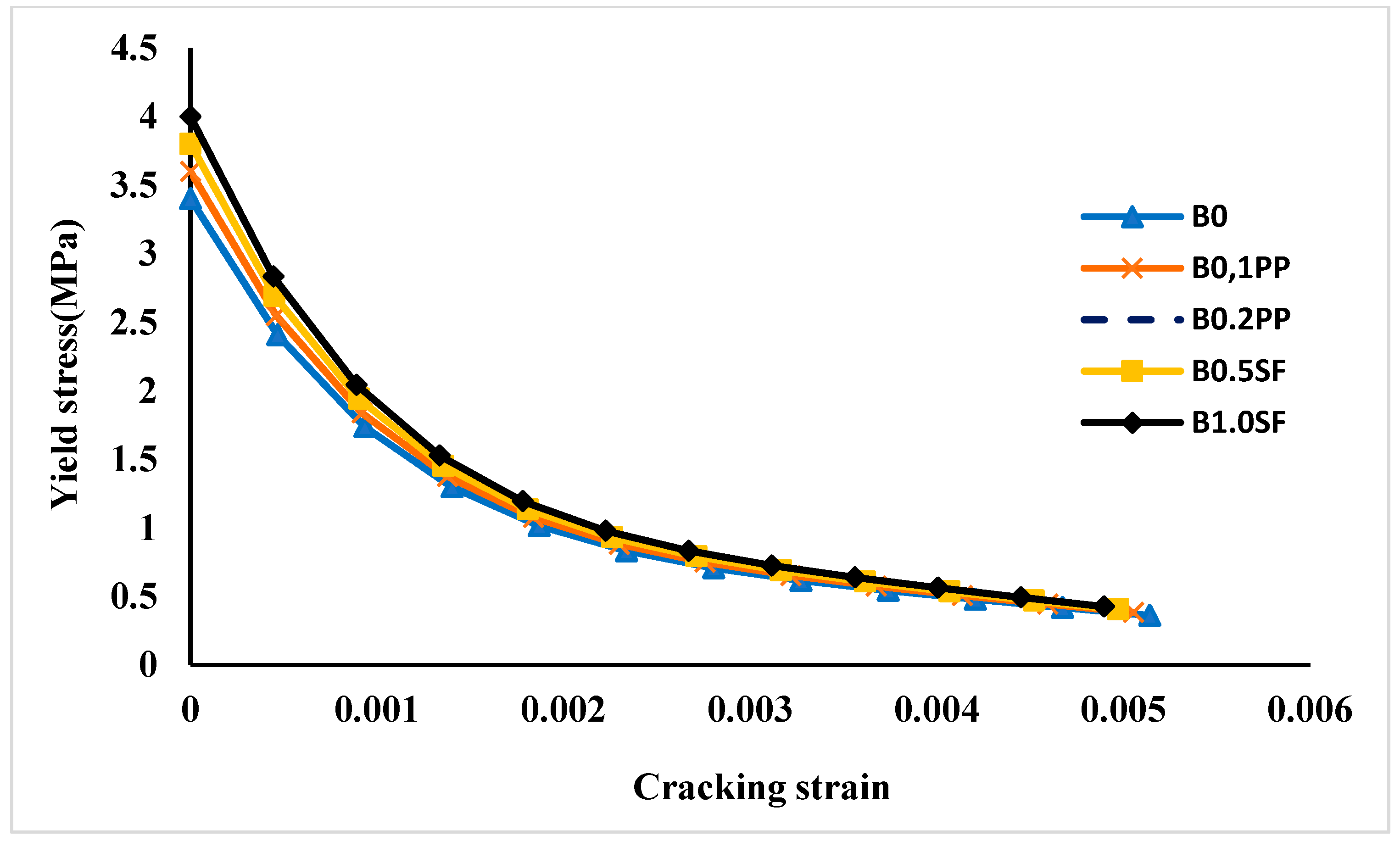
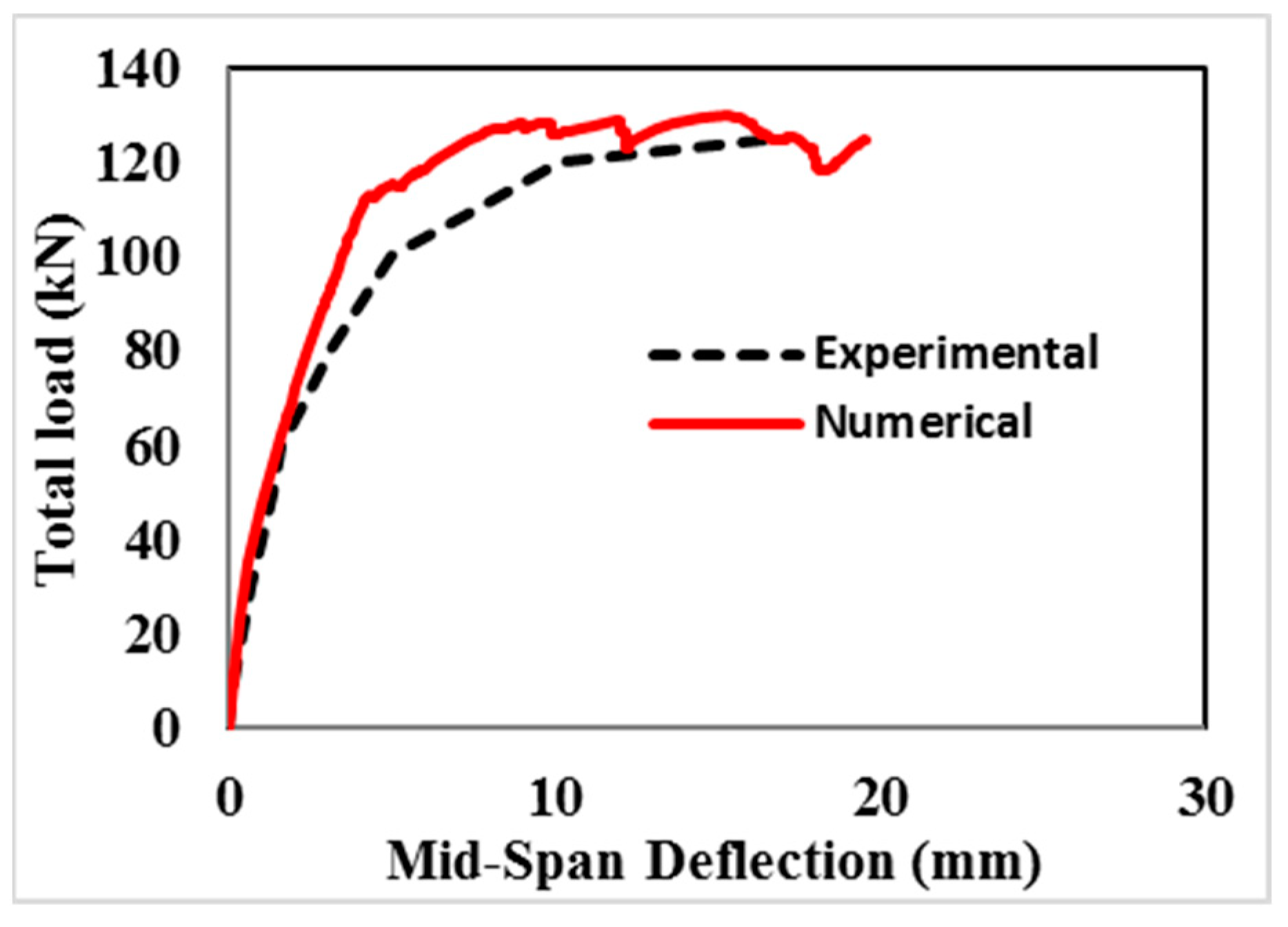
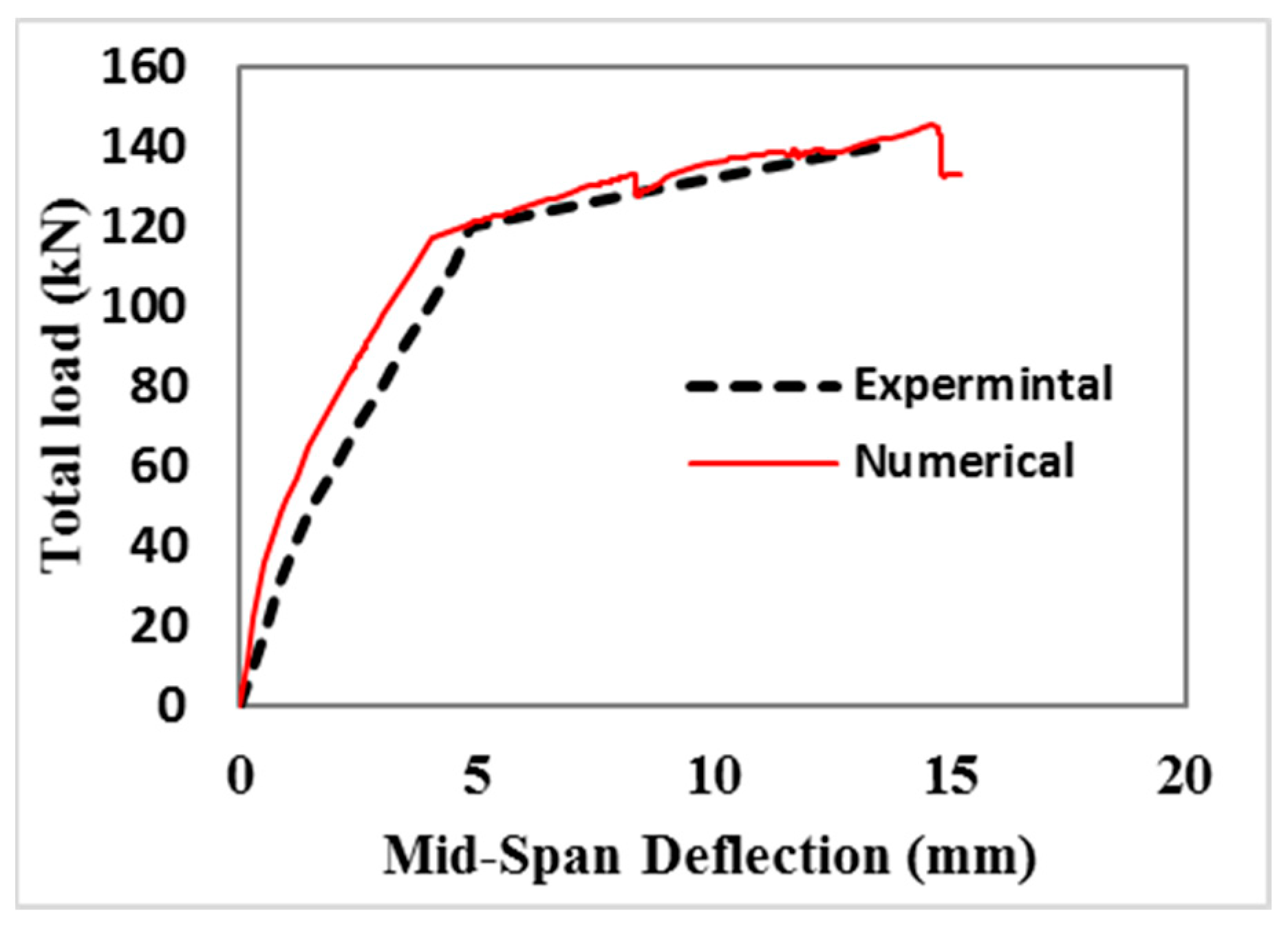



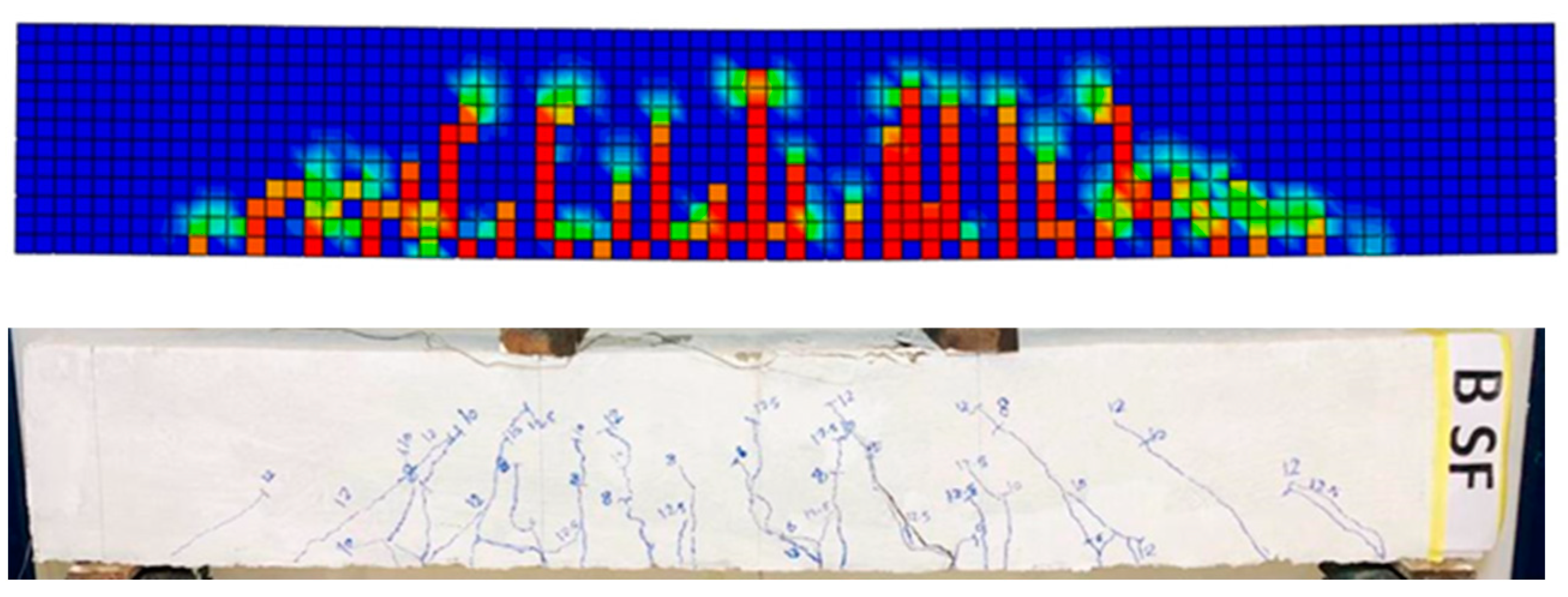


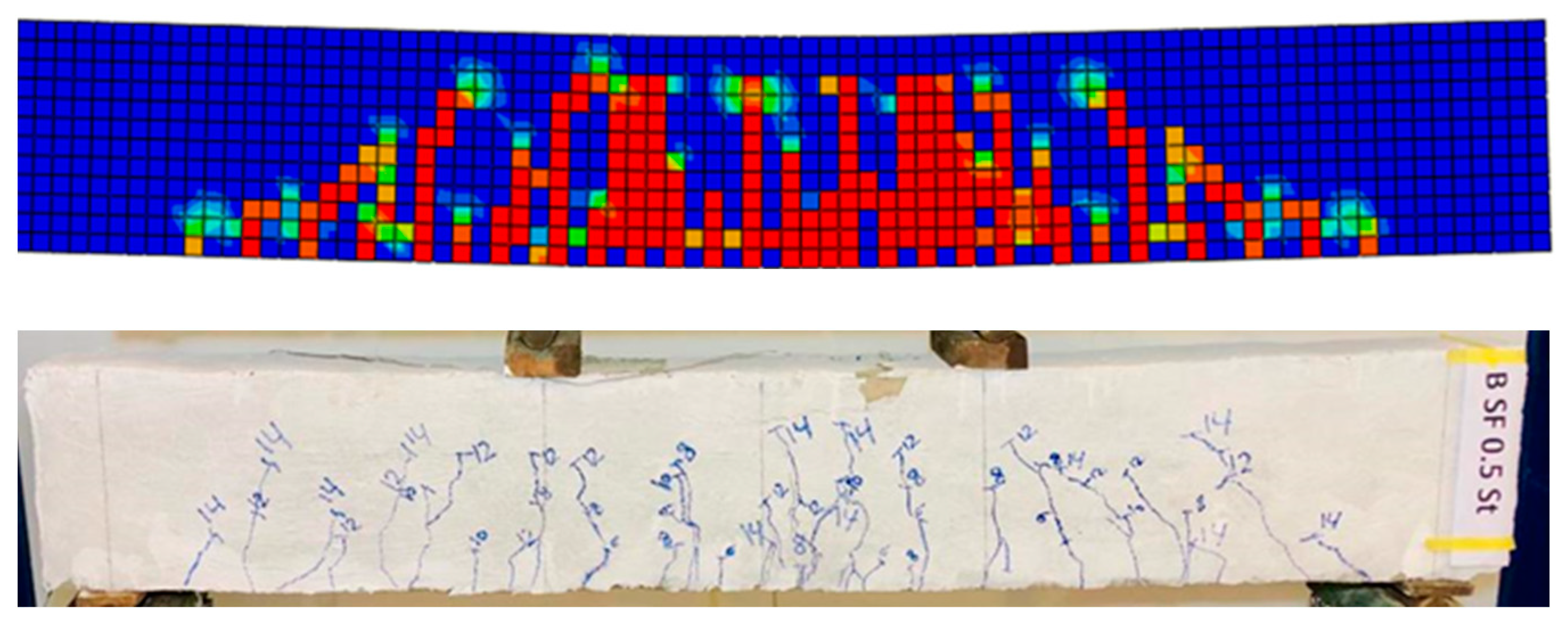
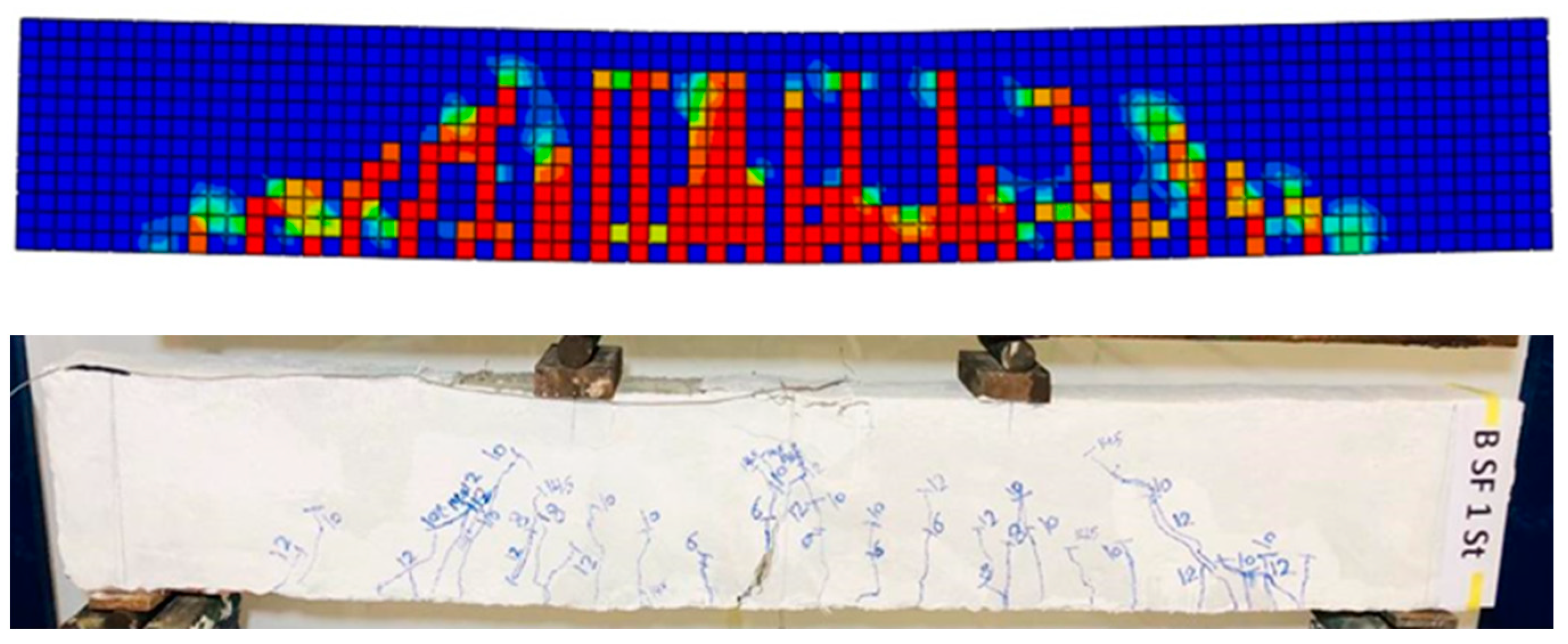
| Aggregate Property | CCBA | FCBA |
|---|---|---|
| Specific gravity (gm/cm3) | 2.17 | 2.10 |
| Bulk density (kg/m3) | 1070 | 1357 |
| Water absorption (%) | 13.8 | 18.0 |
| Yield Strength | Tensile Strength | Elongation | Modulus of Elasticity | Length | Diameter | Aspect Ratio |
|---|---|---|---|---|---|---|
| 610 MPa | 1100 MPa | 21.6% | 210 GPa | 35 mm | 0.8 mm | 43.75 |
| Compressive Strength | Tensile Strength | Modulus of Elasticity | Length | Thickness | Aspect Ratio |
|---|---|---|---|---|---|
| 550 MPa | 450 MPa | 3.5 GPa | 30 mm | 0.3 mm | 100 |
| Mix Label | Cement (kg/m3) | Silica Fume (kg/m3) | FCBA (kg/m3) | CCBA (kg/m3) | Water (kg/m3) | Superplasticizer (kg/m3) | Fiber Content (%) |
|---|---|---|---|---|---|---|---|
| B0 | 432 | 48 | 630 | 770 | 168 | 7.2 | - |
| B0.1PP | 432 | 48 | 630 | 770 | 168 | 7.2 | 0.1% |
| B0.2PP | 432 | 48 | 630 | 770 | 168 | 7.2 | 0.2% |
| B0.5SF | 432 | 48 | 630 | 770 | 168 | 9.6 | 0.5% |
| B1.0SF | 432 | 48 | 630 | 770 | 168 | 9.6 | 1.0% |
| Mix Label | First Cracking Load (kN) | Yield Load (kN) | Max. Loads (kN) | Max. Displacement (mm) |
|---|---|---|---|---|
| B0 | 60 | 90 | 125 | 16.4 |
| B0.1 PP | 60 | 105 | 135 | 19.68 |
| B0.2 PP | 80 | 101 | 140 | 18 |
| B0.5 SF | 60 | 100 | 140 | 13.45 |
| B1.0 SF | 80 | 110 | 145 | 16.88 |
| Dilation Angle ψ | Eccentricity | σbo/σco | Kc | Viscosity |
|---|---|---|---|---|
| 36 | 0.1 | 1.16 | 0.6667 | 0 |
Disclaimer/Publisher’s Note: The statements, opinions and data contained in all publications are solely those of the individual author(s) and contributor(s) and not of MDPI and/or the editor(s). MDPI and/or the editor(s) disclaim responsibility for any injury to people or property resulting from any ideas, methods, instructions or products referred to in the content. |
© 2023 by the authors. Licensee MDPI, Basel, Switzerland. This article is an open access article distributed under the terms and conditions of the Creative Commons Attribution (CC BY) license (https://creativecommons.org/licenses/by/4.0/).
Share and Cite
Elsherbiny, E.A.; Mortagi, M.; Youssf, O.; Abd Elrahman, M.; Madawy, M.E.E. Influence of Steel and Polypropylene Fibers on the Structural Behavior of Sustainable Reinforced Lightweight Concrete Beams Made from Crushed Clay Bricks. Sustainability 2023, 15, 14570. https://doi.org/10.3390/su151914570
Elsherbiny EA, Mortagi M, Youssf O, Abd Elrahman M, Madawy MEE. Influence of Steel and Polypropylene Fibers on the Structural Behavior of Sustainable Reinforced Lightweight Concrete Beams Made from Crushed Clay Bricks. Sustainability. 2023; 15(19):14570. https://doi.org/10.3390/su151914570
Chicago/Turabian StyleElsherbiny, Esraa A., Mohamed Mortagi, Osama Youssf, Mohamed Abd Elrahman, and Mohamed E. El Madawy. 2023. "Influence of Steel and Polypropylene Fibers on the Structural Behavior of Sustainable Reinforced Lightweight Concrete Beams Made from Crushed Clay Bricks" Sustainability 15, no. 19: 14570. https://doi.org/10.3390/su151914570





